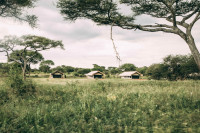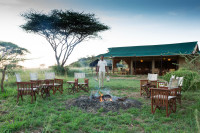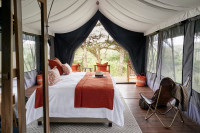
$4,699 to $5,750 pp (USD)
2 travelers on Start dateArrival
Arrival

Day 1
Arrive and Drive to Tarangire National Park
Arrive and Drive to Tarangire National Park
Upon arrival in Tanzania, you'll leave the city of Arusha and head to Tarangire National Park (journey time of approximately three to four hours), located in the Manyara region. Tarangire National Park is the sixth largest national park in Tanzania and the name of the park originates from the Tarangire River, which winds through the park.
Tarangire is a seasonal park and the long dry season (June to October) is the best time to visit, as during these months the park offers incredible wildlife viewing opportunities. You can expect to see plenty of big game, including large herds of elephant congregating along the riverbanks and waterholes. Tarangire is also one of the few parks in Tanzania where you can enjoy night safaris, as well as walking safaris and fly camping trips, please discuss with us if you would like to add on any of these experiences.
- Main Destination:
- Tarangire National Park
- Accommodation:
- Tarangire Tortilis Camp
- Meals & Drinks:

Day 2
Transfer to Lake Manyara National Park
Transfer to Lake Manyara National Park
After breakfast, you'll be driven to Lake Manyara National Park, located beneath the cliffs of the Manyara Escarpment, on the edge of the Rift Valley. The alkaline soda of Lake Manyara, which covers 230 square kilometres, attracts pink flamingos and other bird life. You have time for a game drive in Lake Manyara National Park this afternoon or a range of optional activities like the Treetop Canopy Walk, walking safari or perhaps yoga overlooking Lake Manyara from your camp inside the national park.
You are likely to see resident hippo pods at the lake, tree-climbing lions, large herds of elephant, wildebeest, buffalo, giraffe, zebra, warthog and impala, plus you may be lucky enough to spot leopards and hyenas. There’s also a huge primate population including vervet monkeys and baboons.
- Main Destination:
- Lake Manyara National Park
- Accommodation:
- Lake Manyara Tortilis Camp
- Meals & Drinks:

Day 3
Drive Out from Manyara to Lake Natron
Drive Out from Manyara to Lake Natron
Exit from Lake Manyara National Park and towards Lake Natron, a part of the northern Tanzania safari circuit that is so often missed. It is home to Hominid footprints, the largest breeding ground for lesser flamingos and Ol Doinyo Lengai, the only active carbonatite volcano in the world.
You camp for one night is Lake Natron Camp which is an eco-camp within reach of a host of activities in the region, it has just 10 spacious tents and a wonderful natural, spring-fed swimming pool.
Depending on the time of your arrival, you might like to settle into camp with a sundowner this afternoon or perhaps explore the area right away with your guide or on a walk or by mountain bike.
If you have time we recommend adding a second night here to get the most out of the area.
- Main Destination:
- Lake Natron
- Accommodation:
- Lake Natron Camp
- Meals & Drinks:

Day 4
Lake Natron and Drive to the Serengeti
Lake Natron and Drive to the Serengeti
With an early start, you will have the opportunity to do another activity from Lake Natron Camp before you head to the Serengeti.
If you didn't have the chance yesterday, then we recommend a morning walk along the lake shore to view the lesser flamingos that feed on the algae found in this soda lake. Around 75% of the world’s lesser flamingo population are born at Lake Natron.
The Lake Flats surrounding the water’s edge contain small streams, lakes and hills that provide a variety of hospitable environments for birds that thrive in the alkali oasis. Natron is home to well over 250 species of birds, most of which can be seen from the comfort of the camp itself, or just a short walk away.
Then you will drive to the Serengeti, Tanzania’s most famous national park. The Serengeti offers some of the best wildlife viewing in Africa and is home to the greatest wildlife spectacle on Earth, the Great Migration.
- Main Destination:
- Serengeti National Park
- Accommodation:
- Kiota Camp
- Meals & Drinks:

Day 5
On Safari in the Serengeti
On Safari in the Serengeti
You have a full day on safari in the central Serengeti from the wonderful Kiota Camp, this is a high-quality tented camp with an incredible birds-eye view of the area.
The Serengeti is often thought of as being a vast endless grassy plain, but in reality, the ecosystem is comprised of a wide range of landscapes, with areas of acacia forest, riverine vegetation, soda lakes and granite mountains.
It is best known for the Great Migration which moves between the Serengeti and the Masai Mara in Kenya each year. However, the Serengeti offers much more than just the migration and at all times of the year there is fantastic wildlife, impressive landscapes and a really lovely safari atmosphere.
- Main Destination:
- Serengeti National Park
- Accommodation:
- Kiota Camp
- Meals & Drinks:

Day 6
Head South to the Ngorongoro Crater Rim
Head South to the Ngorongoro Crater Rim
Enjoy a morning game drive in the Serengeti before you head south out of the park and towards the famous Ngorongoro Crater.
Your destination is Sanctuary Ngorongoro Crater Camp. This is an excellent tented camp on the much quieter eastern side of the crater. It is right next to the Lemala Crater access road, so you can get down the crater floor in 15-20 mins from the lodge. Therefore, you will beat many other visitors coming from lodges near Karatu or from other camps, that are further away from an access road, on the crater rim. This is a really good quality tented camp, but it doesn’t have a view of the crater, rather it is surrounded by a beautiful acacia forest so you might also get wildlife around the camp.
- Main Destination:
- Ngorongoro Crater
- Accommodation:
- Sanctuary Ngorongoro Crater Camp
- Meals & Drinks:

Day 7
Safari on the Ngorongoro Crater Floor and Departure
Safari on the Ngorongoro Crater Floor and Departure
With an early morning start, journey to the floor of the Ngorongoro Crater as you enjoy half of the day exploring a unique natural phenomenon and a UNESCO World Heritage Site. The crater is undoubtedly one of the most breathtaking wildlife safari sites in the world, with the 600-metre high crater wall offering incredible wildlife viewing opportunities. You can expect to see a diverse range of wildlife, including buffalo, warthog, wildebeest, zebra, hippo and elephant. There’s also a huge population of predators: lion, hyena and jackal. The resident population of black rhinos is a real treat, as they’re very difficult to spot elsewhere in Tanzania.
From the crater, you will head back to Arusha and this marks the end of your trip. You may well connect with international flights home or decide to hop across the sea for some time relaxing by the beach on the paradise island of Zanzibar.
- Main Destination:
- Arusha (City)
- Accommodation:
- No accommodation (End of tour)
- Meals & Drinks:






































